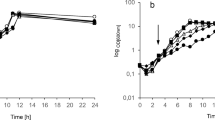Abstract
AnArthrobacter strain isolated from soil and selected for poor ability to utilize hexadecane as sole C-source was grown in a hexadecane (or pentadecane) — salts medium supplemented with yeast extract or corn steep liquor as the source of carbon for growth. It accumulated mono-hexadecanones (or pentadecanones). The percentages to which the individual ketones were accumulated depended on the distance of the carbonyl group from the terminal end of the substrate hydrocarbon; the greater the distance, the lower the percentage. The percentages did not depend on the composition of the medium. No other hydrocarbon oxidation products were observed.
These results are discussed in relation to other reports of microbial conversions of alkanes to ketones.
Similar content being viewed by others
References
Foster, J. W. 1962. Hydrocarbons as substrates for microorganisms. Antonie van Leeuwenhoek28: 241–274.
Fredricks, K. M. 1967. Products of the oxidation ofn-decane byPseudomonas acruginosa andMycobacterium rhodochrous. Antonie van Leeuwenhoek33: 41–48.
Leadbetter, E. R. andFoster, J. W. 1960. Bacterial oxidation of gaseous alkanes. Arch. Mikrobiol.35: 92–104.
Lukins, H. B. andFoster, J. W. 1963. Methyl ketone metabolism in hydrocarbon-utilizing mycobacteria. J. Bacteriol.85: 1074–1087.
Sadtler, S. P. 1964. The Sadtler standard spectra. Vol. 22, spectrum No. 22,437, Sadtler Research Laboratories, Inc., Philadelphia.
Shriner, R. L., Fuson, R. C. andCurtin, D. Y. 1962. The systematic identification of organic compounds. 4th Ed., John Wiley and Sons, New York.
Silverstein, R. M. andBassler, G. C. 1964. Spectrometric identification of organic compounds. John Wiley and Sons, New York.
Stewart, J. E. andKallio, R. E. 1957. An intermediate in the bacterial oxidation ofn-hexadecane. Bacteriol. Proc.1957: 134.
Stewart, J. E., Kallio, R. E., Stevenson, D. P., Jones, A. C. andSchissler, D. O. 1959. Bacterial hydrocarbon oxidation. I. Oxidation ofn-bexadocane by a gram-negative coccus. J. Bacteriol.78: 441–448.
Author information
Authors and Affiliations
Additional information
This research was authorized for publication as paper no. 3331 in the journal series of the Pennsylvania Agricultural Experiment Station, on December 7, 1967.
Rights and permissions
About this article
Cite this article
Klein, D.A., Davis, J.A. & Casida, L.E. Oxidation ofn-alkanes to ketones by anArthrobacter species. Antonie van Leeuwenhoek 34, 495–503 (1968). https://doi.org/10.1007/BF02046471
Received:
Published:
Issue Date:
DOI: https://doi.org/10.1007/BF02046471




